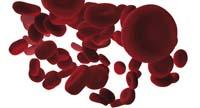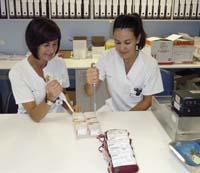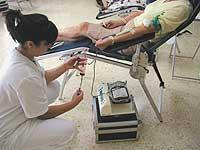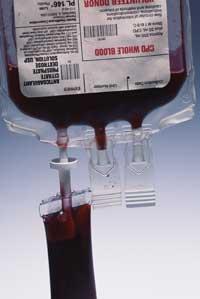Artificial blood far from desired
2010/11/01 Aulestiarte Lete, Izaro - Elhuyar Zientziaren Komunikazioa Iturria: Elhuyar aldizkaria

Precious and vital. That is blood. Our body is essential for its proper functioning. Effective vehicle of oxygen, food and waste. It also performs eleven functions: it protects the body from infections and is responsible for temperature regulation.
As soon as he realized all this, he began somehow the race to find a substitute for blood. The goal is to keep all blood desired for transfusions clean.
Blood donations
At the moment, the supply of blood and its components is in the hands of voluntary providers. Thanks to them many lives have certainly been saved. However, the number of donors decreases daily and demand increases.
As the doctors of the Hematology services of Donostia Hospital, Montserrat Lozano and Nerea Caminos have pointed out, "the current state of donations is characterized by the continuous growth of demand, the decrease in deliveries and the continuous increase in the cost of the measures required to guarantee the safety of transfusions - to the extent that it is necessary to use increasingly sophisticated technologies - for potential pathogens."
As for safety, much progress has been made and doctors are increasingly controlling the compatibility aspects between different blood groups, coagulation and bacterial contamination. But there is always a danger of contagion or reaction after transfusion.
Other disadvantages are homologous transfusions (when the blood ingested is donated by another person). For example, sometimes there are difficulties in getting donated blood, that blood is quickly spoiled and, although it is achieved thanks to donors, blood is expensive. Considering the value of the blood bag and the tests that are performed to ensure that that blood is safe, the price of a blood unit is over 100 euros.
Therefore, Lozano is clear that finding a blood substitute would be "of great strategic interest". "Artificial blood would be able to respond to the needs of emergency transfusions, as well as to cope with situations where special transfusions are required, such as rare groups."
The ideal substitute for blood should meet certain characteristics. And then the challenge is not slow. Beyond getting the amount needed to meet demand, among other things, it is necessary to create totally safe blood. And in addition, you want a more economical, longer blood that serves all recipients. In fact, the supply of universal blood would mean fewer tests, speeding up emergency processes.
Today unfortunately there are no substitutes that meet all these characteristics, although in the last 20 years a billion pounds has been invested in the sector, one of the main investments being that of the American army. However, artificial blood replacement has not yet been approved for commercial use. Despite the achievements, several studies have suggested that blood substitute receptors have a higher risk of heart attack.
It can be said that the current aspirations of scientists are simpler. Since blood and its functioning cannot be fully imitated, its main function is the transport of oxygen, the search for alternatives that fulfilled. In addition to the function of red blood cells, for example, it has tried to replace that of platelets (by residues of lyophilized platelets or adhesive particles).
Oxygen carriers
Two major lines of research have been opened with oxygen carriers: substitutes based on perfluorocarbons and hemoglobin derivatives.

Perfluorocarbons (PFC) is the generic name for compounds formed by fluorine and carbon atoms. It is used in so-called liquid breathing, due to the adequate surface tension to maintain the lung structure and that fluoride is very appropriate to transport oxygen and carbon dioxide and exchange it with the blood. Machine syringes send perfluorocarbon with oxygen to the last pulmonary alveoli. Oxygen is released into the blood and carbon dioxide is collected from the blood, as if it were normal breathing. The machine then extracts most of the perfluorocarbon and repeats the process. The machine itself removes carbon dioxide from the extracted liquid and adds it.
Because the lungs are full of fluid, pressure problems from conventional artificial breathing are avoided, the lungs suffer less stress and breathe more easily. They are generally synthetic and have no risk of infection and can be produced in large quantities. They produce side effects (fever, pulmonary toxicity...).
On the other hand, the search for synthetic hemoglobins (Hb) that can carry more oxygen has long been done in the laboratory, but the results cannot be achieved.
Hb is the body's natural oxygen carrier, the main component of red blood cells. It is a red pigment that gives color to the blood.
But outside the red blood cells, hemoglobin is a problem: it does not carry oxygen as well, when mixed in the blood flow it dissolves with some ease and its components damage the kidneys, even the heart. Therefore, researchers seek to stabilize hemoglobin to avoid toxicity and resort to chemical transformation. We are working with strategies such as encapsulated hemoglobin (surrounded by liposomes), recombined human Hb, obtained from transgenic animals, etc.
The most successful product to date is Hemopure (produced by Biopure in the USA). ), which was approved in 2001, but only in South Africa. Most others are excluded or experimental. "Important efforts have been made to achieve synthetic alternatives to hemoglobin, but clinical sessions have not yet been successfully passed. The results are not very promising," explains Caminos.
Stem cells
Alternatively, it has also had to be used in other ways: "Mature hematopoietic stem cells or embryonic stem cells are intended to obtain red cells. At the moment they do not have sufficient technical maturity to define themselves as a functional alternative, but they can have a great way".
Studies to convert stem cells into blood cells continue to work 10 years ago. In the US, for example, a project of this type was initiated at the University of Wisconsin-Madison in 2001. Embryo stem cells were placed along with bone marrow and growth factors, converting stem cells into blood cells. First, stem cells gave hematopoietic cells, precursors of blood cells and bone marrow. And these hematopoietic cells were replaced by red blood cells, white blood cells, and platelets.
The DARPA, the Pentagon's agency for the research of advanced defense projects, is also at this point in time. It says that the stem cells of an umbilical cord are able to get 20 units of blood (8-10 liters). Has already sent to the FDA (U.S. Food and Drug Administration) the first blood samples obtained. The project must be approved by this one for its advancement.
Nor has the criticism of opponents of studies with embryos been lacking in these years, and we will have to see what all these essays remain in the future. For the moment, it seems that expectations are on that path.

Gai honi buruzko eduki gehiago
Elhuyarrek garatutako teknologia





